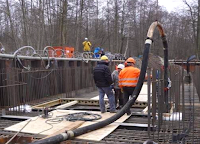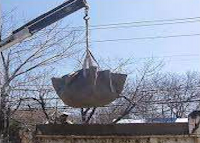Underwater Construction

Underwater Construction
Welcome back to Civil Adda
Hi friends, So far we have discussed many interesting topics.
In the today's post of Civil Adda we are going to learn about something that is related to constructions, constructions that are carried out in water.
Have you ever thought of how constructions are carried out in the water? like that of bridges, dams etc.,
How foundations are laid in water?
And what are the problems that are posed by water during construction work?
All such interesting things are going to be discussed in this post of Underwater Construction.
So at first what is Underwater Construction?
As we all know any construction that is laid in water comes under underwater construction, it may be a tunnel, a bridge, dams or some other.
As we think of a construction, concrete, foundations, construction technology etc., are some of the aspects that come to our mind. And so we are going to deal about all these here in this post one by one.
Except for some constructions like floating bridges, almost each and every construction requires or demands the foundation that is to be laid on the bed. Pillars are not going to be laid directly in the water. The supporting columns or piers are laid on the foundations.
Foundations are laid mostly of 'pile foundations' and are selected with regards to the construction site.
So for underwater constructions, before considering concrete mixtures to be used our main problem is how to lay foundations in water? As digging, laying piles as foundations is a bit difficult task.
For this, there are certain methods that are being followed by the engineers of these days.
To lay foundations, at first we need to isolate water from the site. This is done by caissons and cofferdams.
Now the very immediate question you might get is what are these caissons and cofferdams?
These caissons and cofferdams can be considered as water retaining boxes or these can also be called as watertight boxes.
Once these watertight boxes are built at the construction site in water, these boxes are now dewatered by using suction pipes or some other equipment and that creates some dry space to work on. Later chiselling, drilling and boring are carried out until a hard rock surface is found or reached.
And thus foundations are laid as a base for pillars. These boxes are made by using sheet piles that overlock each other to form a watertight box
If both caissons and cofferdams are both the boxes that would serve same the purpose, then why are we using two different methods of each kind? So There should be some difference among them.Let us have a look at them.
To lay foundations, at first we need to isolate water from the site. This is done by caissons and cofferdams.
Now the very immediate question you might get is what are these caissons and cofferdams?
These caissons and cofferdams can be considered as water retaining boxes or these can also be called as watertight boxes.
Once these watertight boxes are built at the construction site in water, these boxes are now dewatered by using suction pipes or some other equipment and that creates some dry space to work on. Later chiselling, drilling and boring are carried out until a hard rock surface is found or reached.
And thus foundations are laid as a base for pillars. These boxes are made by using sheet piles that overlock each other to form a watertight box
If both caissons and cofferdams are both the boxes that would serve same the purpose, then why are we using two different methods of each kind? So There should be some difference among them.Let us have a look at them.
Caissons
Caissons are also watertight boxes as cofferdams by acting as a substructure in the construction.
Yes, the caisson is a type of foundation which is called as caisson foundation. It is a structure that is sunk into the ground(underwater) for isolation purposes and finally becomes a part of the foundation.
It is a form of deep foundation that is sunk into the ground to the required level by dredging & excavating.
Some worth noting point about caissons are:
- It is used for small areas.
- These are permanent structures.
- These are used when water height is above 12m.
Cofferdams
The word "cofferdam" itself refers to the meaning of "an enclosure" built within.
Unlike caissons, cofferdams are temporary structures that are prepared as a wall inside the water body enclosing the construction area required. Later using the dewatering techniques, water inside the cofferdam is pumped out to provide dry space for working.
Once the work is finished, these cofferdams are removed. These are built by the interlocking of sheet piles by placing them in the required shape.
Some worth noting points regarding cofferdams are:
- These are used for larger areas.
- These are temporary structures.
- These are used when water height is below 12m.
Underwater Boring
In this method of underwater boring, piles are driven or bored at the site, therefore isolation of site using caissons or cofferdams is not required. And excavations are also can be omitted.
Once the piles are bored to the required depth, the water if any is removed and the concreting is done using tremie method.
Methods of placing concrete:
So far we have discussed how the site is isolated and foundations are laid, now comes to the part of concreting work i.e., the techniques involved in placing or pouring concrete underwater.
some of the most common ways of concreting are tremie method, pump method, toggle bags & bag works method.
Let us have some brief idea on these methods of concreting.
Let us have some brief idea on these methods of concreting.
- Tremie Method:
In this method, usually concrete is poured at the desired site by using the long watertight pipes of an inner diameter of 250 mm which are made up of short sections that are commonly joined by screw thread for adjusting the length.
In tremie method concrete is placed below the water level by pouring the concrete from the top of pipe which is actually above the water level using gravity feed method. Gravity feed method is actually using gravity to supply some material or to maintain the flow of material.
The upper part of tremie pipe is having a conical hopper(funnel-like structure) from where the concrete is poured.
Before of placing the concrete, the pipe is checked for any traces of air or water i.e., the pipe should be free from air and water. And the bottom most part of the pipe is covered with a loose plug or cover that is removed once the concrete is made to flow. In this method, concrete is poured at the constant rate which would avoid the setting of concrete in the tremie pipe itself. During the entire process actions like jerking, vibrating is carried out and some admixtures are also added to control the setting time.
If many tremies are working at the same time then there should be a spacing between the two pipes as 3.5 m to 5 m.
This method is the most common method that is used to seal cofferdams & caissons and to construct subaqueous foundations.
- Pump Method:
Both tremie method and pump method are almost one and the same but the pump method differs in the method of transferring concrete. In pump method instead of using the gravity feed method, we use pumping technique so that it would avoid any blockages in the pipe.
Both vertical and horizontal delivering of concrete is possible with this method of pumping. The concrete is squeezed out of the pipe by a diver under the water. It is relatively faster when compared with the tremie method.By using this method concrete can be pumped up to 1000m.
But for massive concreting works of underwater, this method of pumping is avoided mostly. And is an ideal method for small underwater concreting works.
- Toggle Bags & Bagworks:
These methods can be considered as one of the oldest methods of concreting.
In the method of toggle bags, wet concrete is placed inside the bags and are squeezed out by a diver at the site (underwater)
For this method, the reusable canvas bag is used which is filled with concrete and is lowered to the site which is underwater and then the concrete is discharged.
And in the method of bag works the holes and ballast etc., are sealed temporarily with concrete. And the bags are made up of strong fabric which is having a capacity of 10-20 lit and it is also carried out to the desired site underwater by divers.
It is one of the oldest and simplest techniques of placing concrete underwater.The bags are malleable in nature so that they can be interlocks each other easily.Once the bags are placed
they are spiked together with reinforcement bars of small size.
These are some of the most used techniques for underwater concreting.
And these are some of the techniques and aspects behind the works of underwater constructions.
That's all for the today's post.
More of such interesting things are going to be discussed in the upcoming posts.
Your feedback is highly valued.
THANK YOU.
Signing of yours UCY.
they are spiked together with reinforcement bars of small size.







Underwater construction is one of the toughest construction in the World. I think your blog is so informative that from now i am your regular visitor.
ReplyDeletemasonry cracks
repair cracked wall
stainless steel wall ties
cavity wall ties
local builders merchants UK